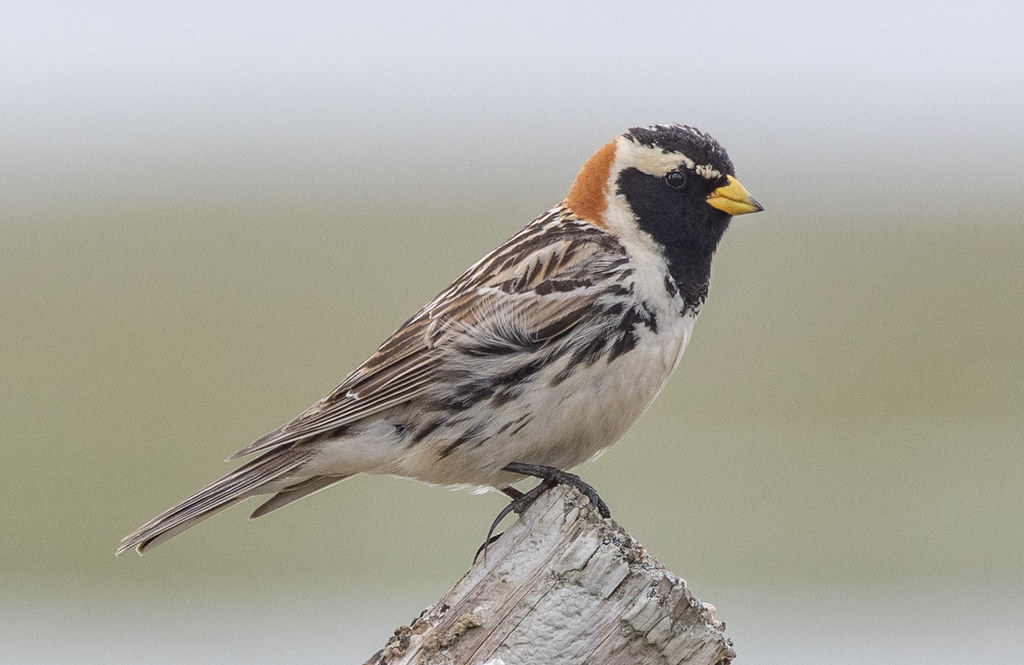Lapland Longspur
| Calcarius lapponicus | Order: Passeriformes | Family: Calcariidae (Longspurs and Snow Buntings) |
The Lapland Longspur is one of the most abundant breeders in North America, spending winter days in the Lower-48 on farm fields where birders flock to see it hanging out with Snow Buntings and Horned Larks. The winter plumage may be a bit drab, but the breeding plumage is strikingly beautiful.
I saw my lifer on Labor Day weekend in 1975 at the beach along Sand Point in the Apostles Islands National Lakeshore and saw many more in the open areas in Columbia County near Madison during the years we lived there. I’ve also seen them many times along the North Shore of Lake Superior and at Park Point during the years we’ve lived here, and on October 1, 1990, saw a small flock right on Peabody Street for my yard list! My most thrilling sightings were in the Nome area of Alaska in June 2022, when the birds were in breeding plumage.
Lapland Longspurs are famous for a very sad reason. On March 13, 1904, a storm hit Minnesota and Iowa. Thomas Sadler Roberts wrote:
The night was very dark but not cold, and a heavy, wet snow was falling with but little wind stirring. Migrating longspurs came from the Iowa prairies in a vast horde, and from about 11 pm until near morning incredible numbers met their deaths in and about villages by flying against buildings, electric light poles and wires, and by dashing forcibly onto the frozen ground and ice, as in their wet, snow-laden, and bewildered condition they whirled and circled about in aimless flight… On two small lakes, with an aggregate area of about two square miles, the ice was still intact and nearly bare from the melting snow. This exposed surface was thickly and evenly strewn with dead longspurs… A conservative calculation showed that there were at least 750,000 dead longspurs lying on these two lakes alone! The adjoining uplands, the streets of the town, and the roofs of the buildings were strewn with bodies in equal numbers. And this was only one locality in the extensive area throughout which the birds were killed.
One hundred of the bodies were dissected…All had died from violence, chiefly crushed skulls, broken necks, and internal hemorrhages… The stomachs of all were entirely empty, though the bodies were fat and in good general condition. This lack of food may have been a contributing factor in the destruction of the birds.
Laura's Published Works
Radio Programs
- Record-breaking Snow and Climate Change 2023
- Smith's Longspur! 2020
- Listener's Favorite Birds #4: Erik's Gyrfalcon 2018
- Smith's Longspur 2017
- The Cruelty of an April Wind 2016
- Hawk Ridge Update 2014
- Birding by Amtrak 2014
- Mayday! May Snow Storms 2013
- Birds falling from the sky: sign of the Apocalypse? 2011
- October 2006 Bird Update 2006
- Smith's Longspurs 2006
- Cool Migration: 2004 2004
- Lakewood Pumping Station 1996
- Groundhog Day 1996
- Searching for the Elusive Groove-billed Ani 1995
- Big Day 1995 1995
- Bad Spring Weather 1991
- Migration Hows and Whys 1989
- Autumn's End 1988
- Identifying birds in flight 1988
- WHOA! Big Day at the Pumping Station 1988
- Pot Pourri 1987
- October Sparrows 1987
- Ode to the Lakewood Pumping Station 1987
- Snow Bunting 1986
